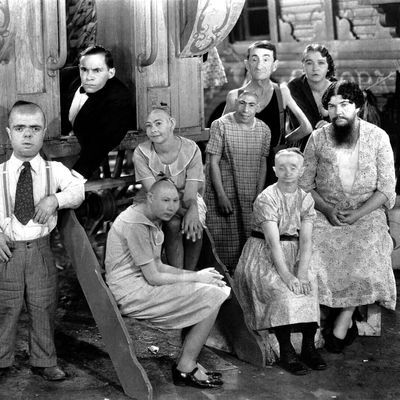
American Horror Story: Freak Show debuted last night, heir to a long legacy of stories built around the weird world of sideshows and human oddities. If AHS has whet your appetite for more of the same, step right up and peer behind the curtain for 11 strange and splendid displays of fiction at its freakiest.
Freaks
Based loosely on Tod RobbinsÔÇÖs 1923 short story ÔÇ£Spurs,ÔÇØ Tod BrowningÔÇÖs 1932 pre-code horror flick stands alone as a subgenre of one. Freaks is notable mostly for its inversion of the traditional evil-freaks-versus-good-guy-normals: In Freaks, the human oddities and sideshow performers are sympathetic and humanized as they face off against a predatory trapeze artist and her strongman boyfriend. The movie was a spectacular flop ÔÇö it all but destroyed the career of Browning, who had directed Bela Lugosi in Dracula the year prior, and was blamed for at least one miscarriage when it was first released. But after a 1962 revival at Cannes, itÔÇÖs risen to a high seat in the cult canon, with homages and parodies in pop culture from Clerks to The Simpsons.
The X-Files, ÔÇ£HumbugÔÇØ
Set in the circus town of Gibonston, Florida, the second-season episode ÔÇ£HumbugÔÇØ is notable less for its cast of human oddities ÔÇö including self-styled modern sideshow stars Jim Rose and the Enigma ÔÇö and more as the first episode solo-written by X-Files behind-the-scenes star Darin Morgan. As a monster-of-the-week entry, Vincent SchiavelliÔÇÖs parasitic conjoined twin is one of the showÔÇÖs sillier ones, but the episode crystallized MorganÔÇÖs trademark dark humor and flare for the self-consciously weird.
Evelyn Evelyn
Remember the time Amanda Palmer and Jason Webley put out a concept album and graphic novel as a pair of conjoined twin sisters? Because that definitely happened. Evelyn Evelyn is the Series of Unfortunate Events of sideshow drama, pushing tragedy so hard, it comes full circle into the absurd. ItÔÇÖs worth noting that albumÔÇÖs original viral campaign, which presented the twins as artists Palmer and Webley had discovered, fell flat: The kind of tragedy that can play for laughs in fiction takes on a very different timbre when itÔÇÖs presented in a real-world context. [Disclosure: I worked on the Evelyn Evelyn book as an associate editor and have a current professional relationship with artist Cynthia von Buhler.]
Geek Love
If Freaks is the definitive sideshow movie, Katherine DunnÔÇÖs 1989 novel Geek Love holds an equivalent place in the literary canon. A National Book Award finalist, Geek Love is narrated by Oly, one of a family of children whose parents (both self-made oddities) decided to breed their own freak show. Geek Love is hard to wiggle into a single genre category ÔÇö magical realism comes close, but doesnÔÇÖt really cover the bookÔÇÖs range or intensity: ItÔÇÖs a difficult, disturbing, and profoundly rewarding read.
Mr. DarkÔÇÖs Carnival, Something Wicked This Way Comes
While the sideshow of Ray BradburyÔÇÖs Something Wicked This Way Comes lingers on the periphery of the larger story, it has its share of human and not-so-human oddities. And, like all good sideshow fiction, it blurs the line between audience and exhibits as Mr. Dark taps into his marksÔÇÖ deepest desires, then consumes and regurgitates them as pieces of his traveling show.
Freakshow
Before there was American Horror Story: Freak Show, there was plain old Freakshow: a 2006 animated series created by and starring H. Jon Benjamin and David Cross as conjoined twins leading a freak show that moonlighted as a hapless superhero team. An oddity among oddities, Freakshow aired for a single seven-episode season before fading into obscurity.
Carnivàle
Daniel KnaufÔÇÖs HBO series Carniv├ále took sideshows to new heights of Lynchian weirdness, setting its circus amid a complex supernatural mythos and multigenerational battle between good and evil. The supernatural angle changes the contest of Carniv├áleÔÇÖs freaks significantly: In a world as strange as the showÔÇÖs, the bar for ÔÇ£normalÔÇØ moves accordingly.
Billy the KidÔÇÖs Old-Timey Oddities
Given that Goon cartoonist Eric Powell is a master of the gnarly weird, Billy the KidÔÇÖs Old-Timey Oddities, a comics series in which the famous bandit fakes his death and ends up throwing in his lot with a traveling freak show to shoot his way through supernatural mysteries, is weirdly tame. ItÔÇÖs about freak shows as a motif rather than a theme, and once you get past the basic physical strangeness of its cast, itÔÇÖs missing most of what makes sideshow stories most interesting ÔÇö the funhouse-mirror commentary on humanity (for that, best stick with The Goon).
Zippy the Pinhead
Bill GriffithÔÇÖs cult-classic comic strip isnÔÇÖt actually about sideshows, but it merits inclusion on this list because its main character, the eponymous Zippy, is based on Schlitzie, the microcephalic performer Griffith first saw in a screening of (you guessed it) Tod BrowningÔÇÖs underground classic┬áFreaks. While Zippy has little in common with his real-world twin ÔÇö Zippy regularly argues philosophy, while Schlitzie was generally cited as having roughly the cognizance of a 3-year-old ÔÇö the inspiration and resemblance puts Zippy firmly in the tradition of freak shows and their cross-media derivatives.
Big Fish
In fiction, freaks tend to be metaphors, funhouse mirrors for humanity, or parables about the shallowness of superficial beauty. Tim BurtonÔÇÖs 2003 film takes the metaphor a step further. Whether its oddities are genuine or fictions created by larger-than-life liar Ed Bloom remains ambiguous.
Secrets of the Sideshows
The other works on this list are fiction, but if youÔÇÖre curious about the fact behind the fantasy, Secrets of the Sideshow, by prominent skeptic, performing magician, and former carnival pitchman Joe Nickell, is one of the best and most comprehensive histories in the world of sideshow performers.

